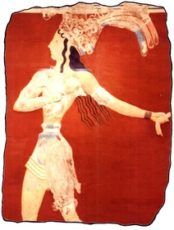Plasterboard - Prinz in the lily field of Knossos
Plasterboard with motif "Prince in the Field of Lilies" approx. 17 x 22 x 1.5 cm
One of the most beautiful motifs is the "Prince of Lilies": a naked youth, dressed only in loincloth, with a magnificent crown of feathers, under which long black curls curl out, striding through a field of waist-high flowering lilies.
Contents: A plaster plate, a template with borders, a painting or colouring guide, a sheet of carbon paper. A short instruction.
| Aspiration scale: | Easy |
|---|---|
| Time Line: | 1,5 Hours |
The Minoans
They were the first advanced civilisation in Europe, their seafarers dominated the Mediterranean for centuries and their bull cult was the model for the legend of the Minotaur: the Bronze Age empire of the Minoans, named after the legendary king Minos, is still legendary today.
The Minoans built large palace complexes on Crete around 5,000 years ago, constructed roads and developed a script that is still undeciphered today. Their sphere of influence stretched from the Aegean islands to Cyprus and the coast of Asia Minor to Mesopotamia and Egypt. But as magnificent and archaeologically productive as Minoan palaces such as Knossos or Phaistos are, their builders still pose numerous riddles to researchers. The reason for the decline of the legendary Minoan empire is also not clearly understood.
The Prince of the Lilies
Crete around 1400 BC - the end of the Minoan era. The ancient Greek historian Philóstratos of Miletus learns about the astonishing culture of the Minoans during his stay at the palace of Knossos and gains insights into the lives of the palace inhabitants, including the eccentric "Prince of the Lilies".
The famous palace of Knossos extended over a large area. Multi-storey building complexes are arranged around a central courtyard: Halls, among them the so-called throne room, pillared halls corridors, cult rooms, storerooms or workshops. Staircases connected the different floors with each other. Here and there, reconstructed wall sections and frescoes can be found today, including the figures in the south wing: the Tribute Bringer and the Prince in the Lily Field.
This "Prince of the Lilies" relief was found by archaeologist Sir Arthur Evens lying smashed on the floor and pieced together to form the image we know today. However, there are reasonable suspicions that this depiction does not correspond to the original, but was created with imagination by Sir Evens. Be that as it may, it is a beautiful motif.

